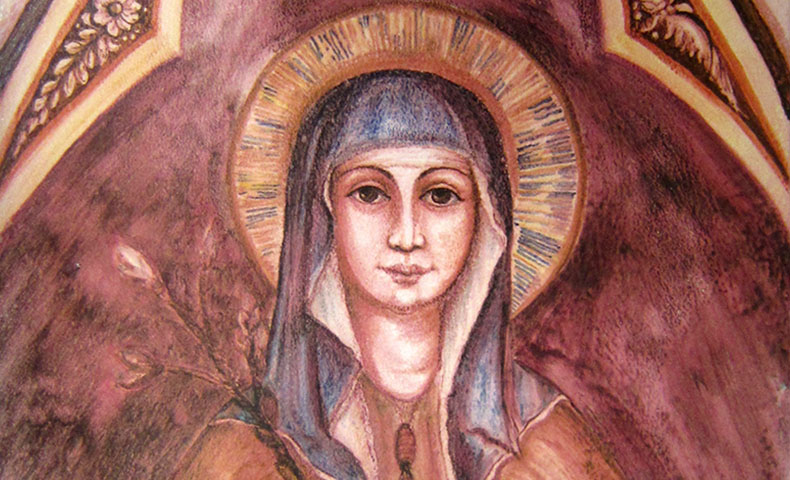
Today we continue our regular series called “Learning from the Saints.” Our guide is expert Bert Ghezzi, a dear friend of mine and the author of numerous books including Voices of the Saints, Saints at Heart, and Discover Christ: Developing a Personal Relationship with Jesus.
His more recent books are The Power of Daily Mass and The Heart of Catholicism. You can learn more about Bert and his work at BertGhezzi.com.
Today, Bert profiles St. Clare of Assisi, the patron of television, eye disease, embroiderers, and good weather, whose feast day is today.

Clare was already a faithful Christian when she first met St. Francis of Assisi in 1211, but his total dedication to Christ sealed her convictions. Clare decided that she also wanted to live by the gospel as simply as possible.
She determined compare herself to Jesus as though looking in a mirror. She expected to conform her behavior to his image, and she taught others to do the same. For example, she exhorted Queen Agnes of Bohemia to look at herself in Christ-the-mirror:
“Happy the soul to whom it is give to attain this life with Christ, to cleave with all one’s heart to him whose beauty all the heavenly hosts behold forever;
whose love inflames our love;
whose contemplation is our refreshment;
whose graciousness is our delight;
whose gentleness fills us to overflowing;
whose remembrance gives sweet light;
whose fragrance revives the dead;
whose glorious vision will be the happiness of all the citizens of that heavenly Jerusalem.
For he is the brightness of eternal glory (see Heb 1:3), the splendor of eternal light, the mirror without spot (see Wis 7:26).
Look into that mirror daily, O queen and spouse of Jesus Christ. Always study your face in it, so that within and without you may adorn and clothe and gird yourself with all manner of virtue. So by God’s grace you can contemplate blessed poverty, holy humility and sacred charity, which are reflected in that mirror.”
Francis invited Clare to lead a community of women who would live like his friars. On Palm Sunday, 1212, Clare met him and his brothers at a chapel where she committed herself to live by the gospel in poverty and chastity. Clare’s family was outraged because they felt she had disgraced them. Relatives even tried to bring her home forcibly, but she held firm. In a short time things calmed down, and many prominent women of Assisi, including her sister and mother, joined her.
Francis gave Clare a house near the church of San Damiano outside the walls of Assisi. There she and her sisters happily followed a severe pattern of life. The women wore rough habits, went barefoot, fasted often, slept on the floor, abstained from meat entirely and spoke only when necessary.
Like Francis, Clare was determined to imitate Christ’s poverty. She wanted her sisters to own nothing and live on daily contributions. “O blessed poverty!” she wrote to her friend Queen Agnes:
“To those who love and embrace her she gives eternal riches. O holy poverty! to those who possess and desire her, God promises the kingdom of heaven and bestows eternal glory and the blessed life. O poverty whom the Lord Jesus Christ deigned to embrace so completely!
“Rejoice and be glad that so great and good a Lord, on coming into the Virgin’s womb willed to appear despised, needy and poor in this world, so that men who were in dire poverty and suffering great need of heavenly food might be made rich in him.”
Within a few years, convents of Clare’s followers popped up in Italy, France and Bohemia. Clare seems to have had a gift of healing which blessed her sisters and neighbors. But she herself was ill for 27 years before she died in 1253.
Read more from Bert at his website www.BertGhezzi.com, or check out his many books on Amazon.
